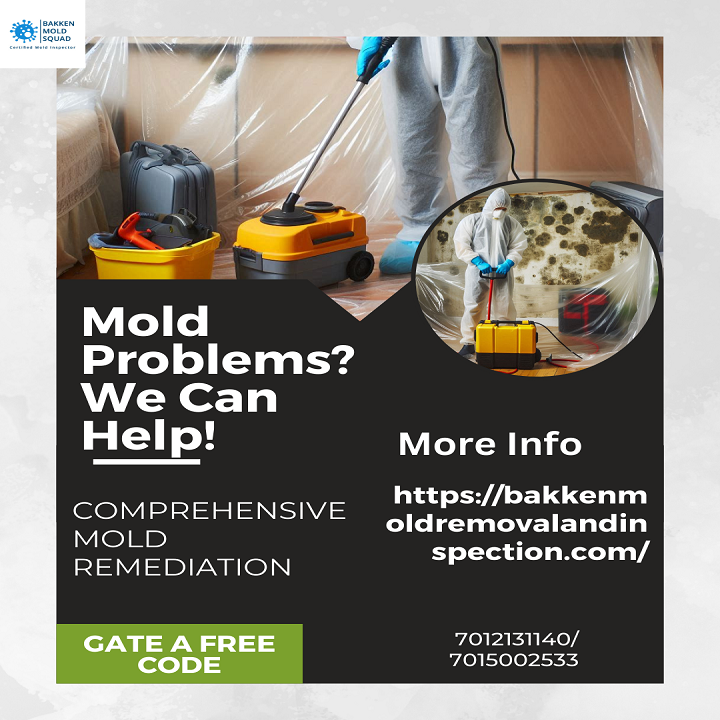
Mold growth on walls is not just unsightly, it can lead to structural damage and pose health risks to you and your family. If left untreated, mold can spread and become a much bigger problem, potentially affecting the integrity of your property. At Bakken Mold Squad, we specialize in mold inspection, testing, and removal for homes and businesses in the Williston, ND area. In this guide, we’ll walk you through the steps to safely remove mold from walls and explain when it’s best to call in professionals for help.
Understanding Mold Growth
Mold thrives in moist environments, so areas prone to humidity, leaks, or poor ventilation are at a higher risk for mold infestations. Bathrooms, basements, and kitchens are common places for mold to grow. Mold on walls can appear as black, green, or even white patches, and in many cases, you might notice a musty odor before you see visible signs of mold.
While minor mold issues can sometimes be addressed on your own, larger mold problems (anything more than 10 square feet) should always be handled by professionals. At Bakken Mold Squad, our team is fully trained and equipped to safely eliminate mold, ensuring it doesn’t return.
Steps to Remove Mold from Walls
If you’ve identified mold on your walls and are ready to tackle it, follow these steps to ensure safe and effective removal:
1. Assess the Situation
The first step is determining how widespread the mold problem is. Small, isolated patches can usually be cleaned with household materials. However, if the mold has spread extensively or penetrated porous materials like drywall, it’s best to call in a professional mold removal company like Bakken Mold Squad.
2. Gather Protective Gear
Mold spores can cause allergic reactions, respiratory issues, and other health problems, so it’s essential to protect yourself. Wear gloves, a mask, and safety goggles to prevent direct exposure to mold spores. If you have asthma or a compromised immune system, it’s highly recommended to avoid any direct contact with mold.
3. Prepare a Cleaning Solution
There are several safe and effective cleaning solutions for removing mold:
- Detergent and Water: A simple mixture of water and dish soap can work for non-porous surfaces.
- White Vinegar: Vinegar has anti fungal properties and is effective at removing mold from most surfaces.
- Hydrogen Peroxide: A 3% hydrogen peroxide solution can kill mold and lift stains.
Avoid using bleach unless absolutely necessary. Although bleach can kill surface mold, it does not penetrate porous materials and may leave behind moisture that encourages further mold growth.
4. Clean the Mold
Dampen a sponge or scrub brush with your cleaning solution and gently scrub the moldy area. For larger infestations, use a stiff-bristled brush. Always start with a small test patch before cleaning larger areas, especially on painted walls, to ensure the solution doesn’t cause damage.
5. Dry the Area Thoroughly
Once the area is cleaned, it’s critical to dry it completely. Mold thrives in damp conditions, so any remaining moisture can cause it to grow back. Use fans, dehumidifiers, or open windows to ensure proper ventilation and drying.
6. Fix the Underlying Issue
Mold is often a symptom of a bigger problem—whether it’s high humidity, poor ventilation, or a water leak. To prevent future mold growth, address these underlying causes. You may need to fix leaks, improve air circulation, or use a dehumidifier in problem areas.
When to Call in Mold Removal Experts
While small mold issues can sometimes be managed with DIY methods, there are situations where professional intervention is necessary:
- Large infestations: If mold covers a large area (over 10 square feet), it’s safer to let professionals handle the removal.
- Recurring mold: If you clean the mold but it keeps coming back, it’s a sign of a deeper issue that needs expert attention.
- Health concerns: Mold exposure can be dangerous, especially for people with asthma, allergies, or weakened immune systems.
- Hidden mold: If you suspect mold is growing behind walls, under flooring, or in HVAC systems, professional inspection and removal are crucial.
At Bakken Mold Squad, we use advanced techniques and equipment to thoroughly remove mold and restore your property to a healthy, mold-free condition. Our services start with detailed mold inspection and testing to pinpoint the source of the problem. From there, we create a custom mold removal plan tailored to your property’s needs.
Preventing Mold from Returning
Once mold has been removed, it’s essential to take steps to prevent mold from coming back:
- Control Humidity: Use a dehumidifier in high-moisture areas like basements and bathrooms to keep humidity levels below 50%.
- Fix Leaks Immediately: Whether it’s a roof, window, or plumbing leak, addressing water issues promptly will prevent moisture buildup.
- Improve Ventilation: Ensure that bathrooms, kitchens, and laundry rooms are properly ventilated to reduce excess moisture.
- Inspect Regularly: Keep an eye on problem areas and check for signs of mold regularly, especially after storms or high-humidity periods.
Call Bakken Mold Squad for Professional Mold Removal in Williston, ND
Mold removal can be a challenging task, especially when dealing with large infestations or hidden mold. At Bakken Mold Squad, we are here to help homeowners and businesses in Williston, ND, and surrounding areas with professional mold remediation services. Whether you need a thorough mold inspection, removal, or preventative treatment, we have the expertise to get the job done right.
Don’t let mold take over your property! Contact Bakken Mold Squad today at 701-213-1140 or 701-500-2533 for expert mold removal services in Williston, ND. We’re here to restore your home or business to its clean, safe, and mold-free condition.